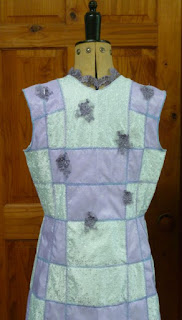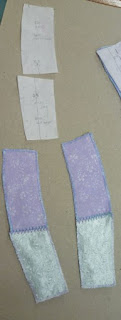The little bolero was sewn up. Lace scallops were added to the gown and the bottom of the bolero.The scallops were already on the back because I had enough to cut it that way, but I had to add them to the front pieces.
front
back
I hadn't got enough of the scallops to put round the neck of the gown as well as the neck of the bolero. So, I decided to attach the bolero and the gown. Another reason was that with all the quick changing that has to take place for the Fashion show, I didn't want the bolero lost or damaged.And then I played with a bit of the rest of the lace and came up with 'sleeves'... Actually 'drapes' from the top of the armscye.
The first one worked wonderfully and I started on the other side. But at this stage it was near the end of the day. I wanted to take photos that would be close enough to the finished product to send off before the deadline for their catalogue. I also wanted the background to be the beautiful blue curtains in the community centre(covering a large mirror).
So, photos staged for front and back view so as to see the one sleeve pinned just right.
So, front
and back.
And then it took me several hours when I got home to write the statement!
As you know, I have no problem coming up with words, but trying to trim them to around 50 words "of descriptive text and image - include fabrics, techniques and patterns used." Well.
So, I did go a bit over 50, but not much.
‘Lilac and Lace’
Sandy’s ‘patchwork’ is developed from her own garment design. Each carefully numbered pattern section was cut from taffeta and embroidered satin. Sandwiched pieces edged with zigzag were butted together and joined with a bridging stitch. A friend’s discarded lace fragments are now a graceful bolero topped with a sprinkle of embellishments.
Sandy’s ‘patchwork’ is developed from her own garment design. Each carefully numbered pattern section was cut from taffeta and embroidered satin. Sandwiched pieces edged with zigzag were butted together and joined with a bridging stitch. A friend’s discarded lace fragments are now a graceful bolero topped with a sprinkle of embellishments.
As you can see from what I have told you, the embellishments are still to come. But the photos will not be all that big in the catalogue...and the drama/theatre/surprise will be the sparkle in the darkened room with the spotlights on the gown.
Or that's my story.
And I am looking forward to relaxing my way through July stitching beads and sequins onto the lace and gown. Not an overwhelming amount...just enough for the sparkle on the catwalk look.
I am quite pleased to get it to this point in 2 weeks instead of the month I had planned to have. I sent off the photos and statement late Saturday evening and got confirmation on Sunday. So, yesterday and today I have been getting the sleeves sorted and the lining sewn in.
And figuring out the part of how the model will get in and out of it! At this point, the front in the photo is pinned!

















































